人教版高中英语必修4Women of achievement Unit 1语法主谓一致 课件(38张ppt)
文档属性
| 名称 | 人教版高中英语必修4Women of achievement Unit 1语法主谓一致 课件(38张ppt) | 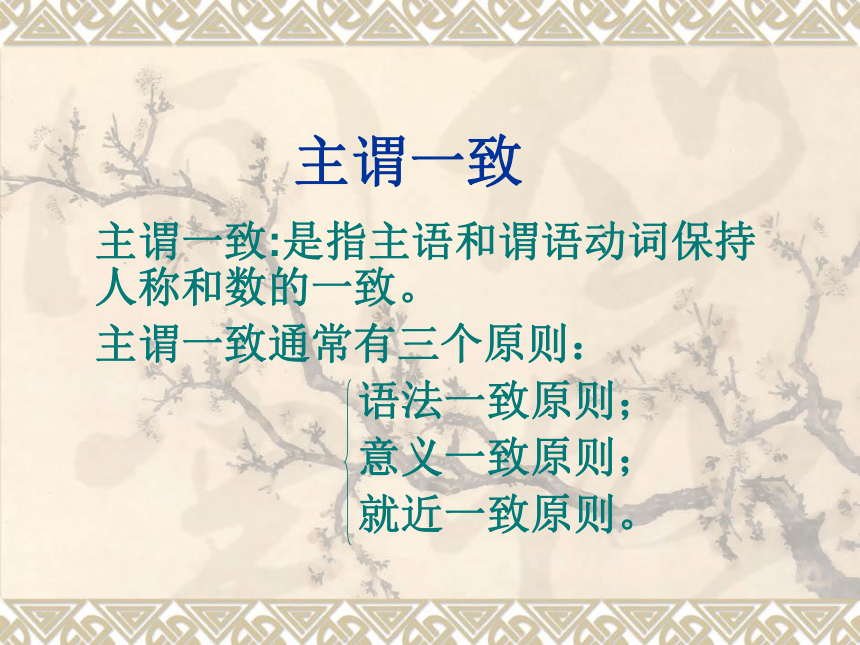 | |
| 格式 | zip | ||
| 文件大小 | 633.0KB | ||
| 资源类型 | 教案 | ||
| 版本资源 | 人教版(新课程标准) | ||
| 科目 | 英语 | ||
| 更新时间 | 2021-04-15 09:58:28 | ||
图片预览



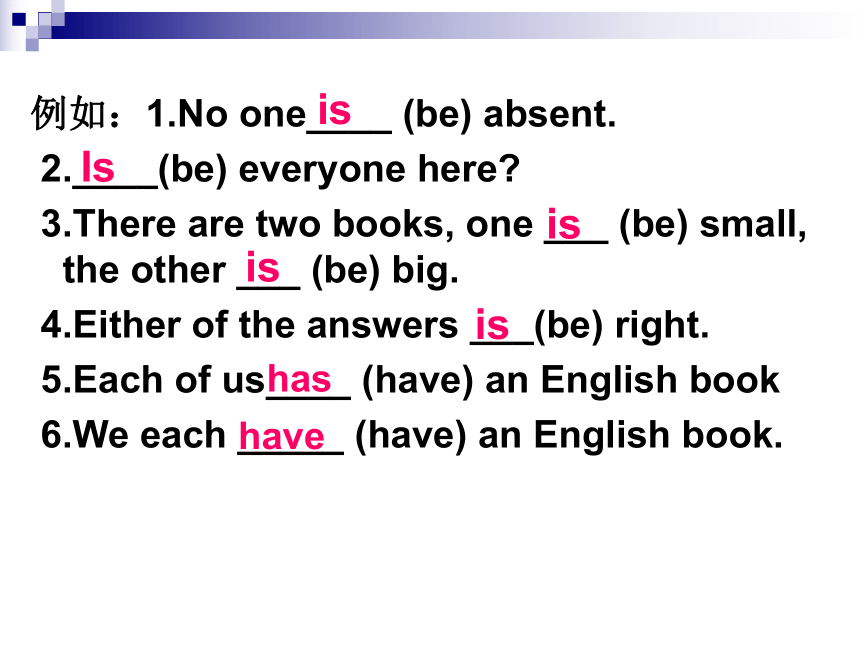
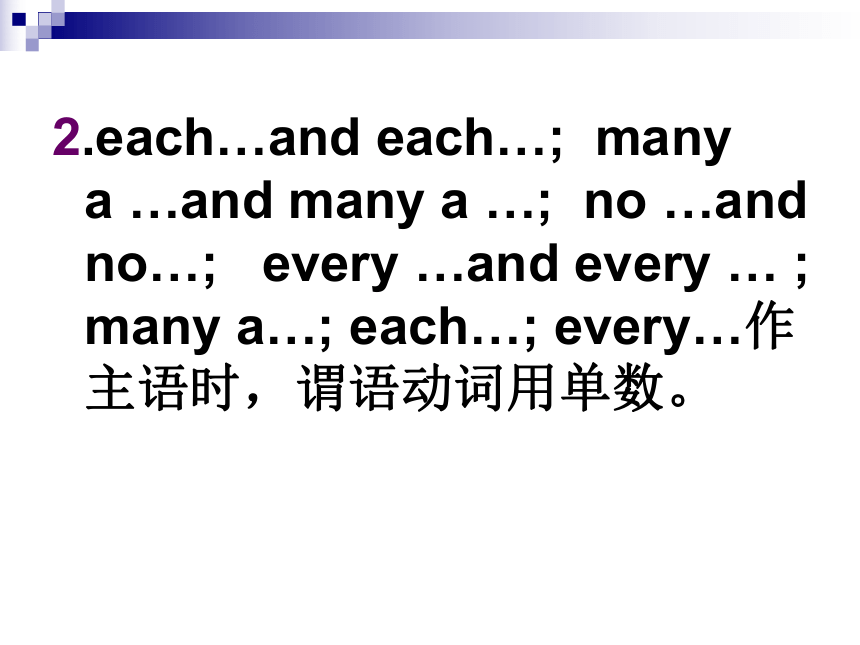

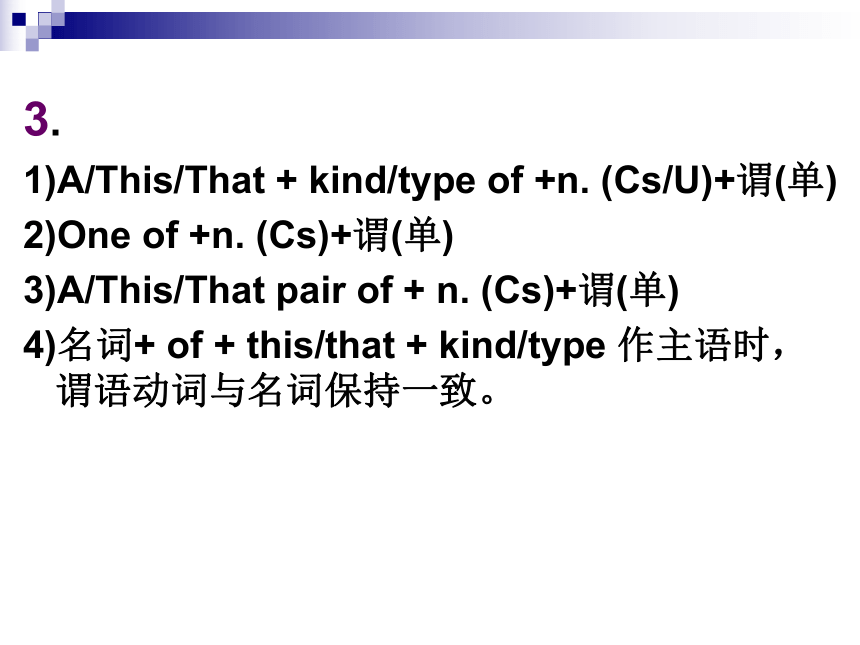
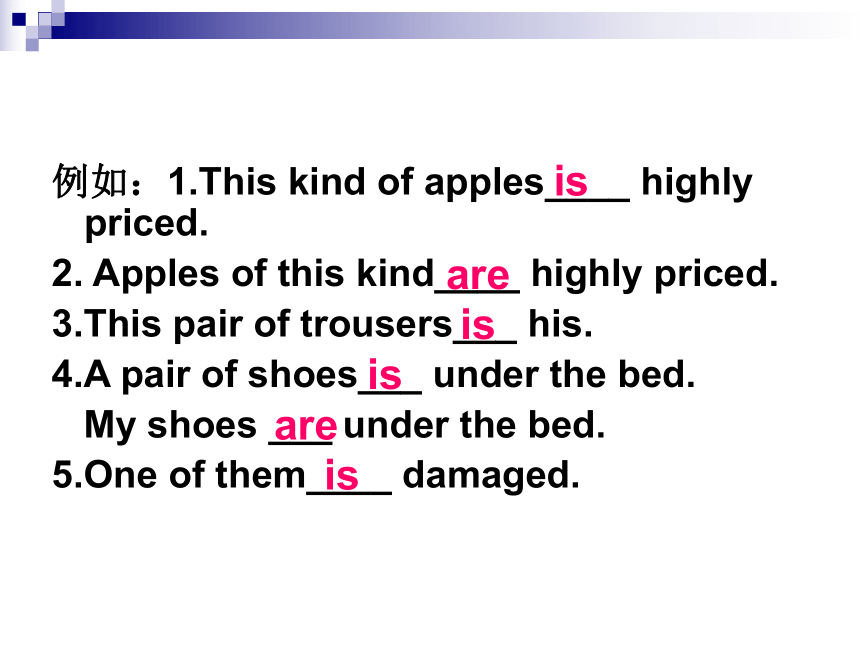

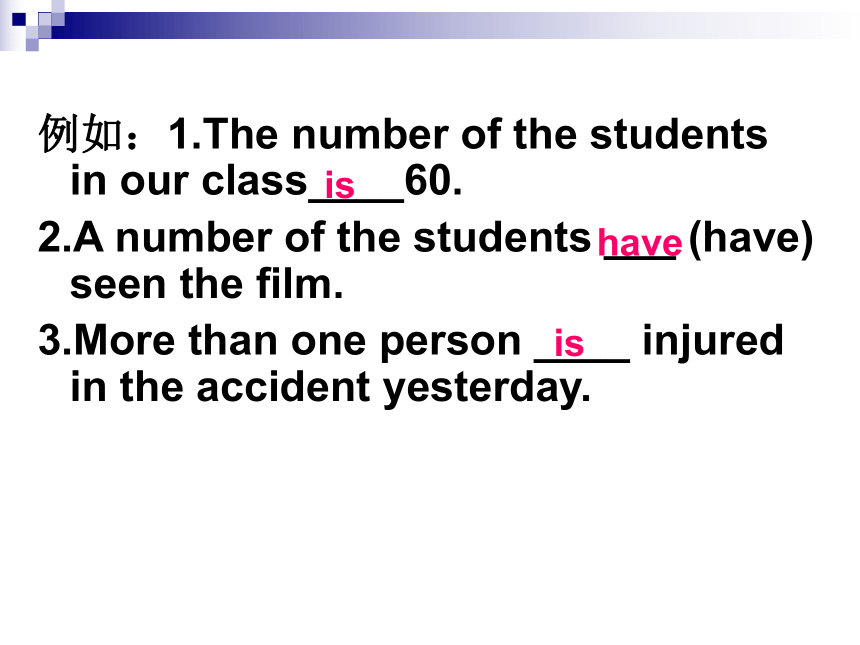
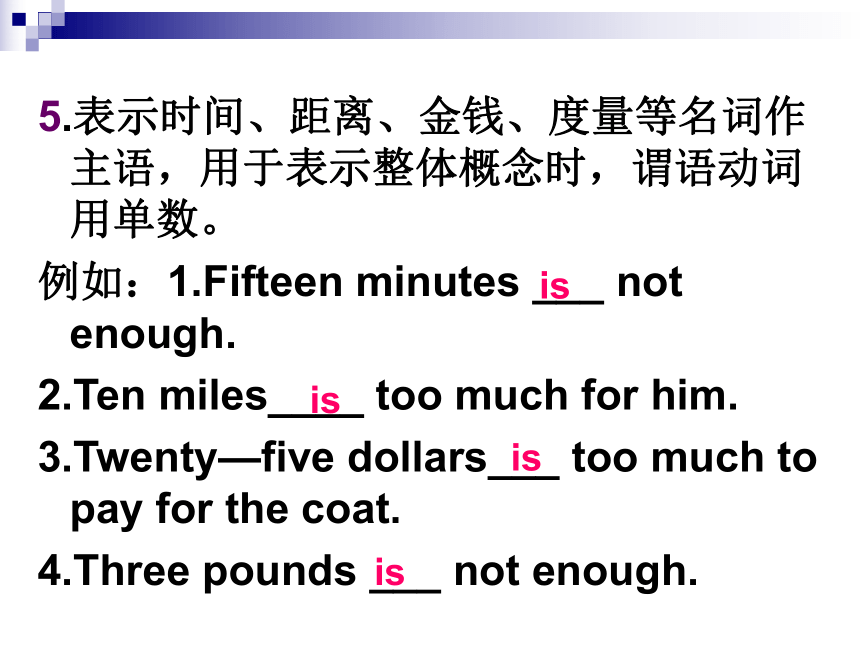
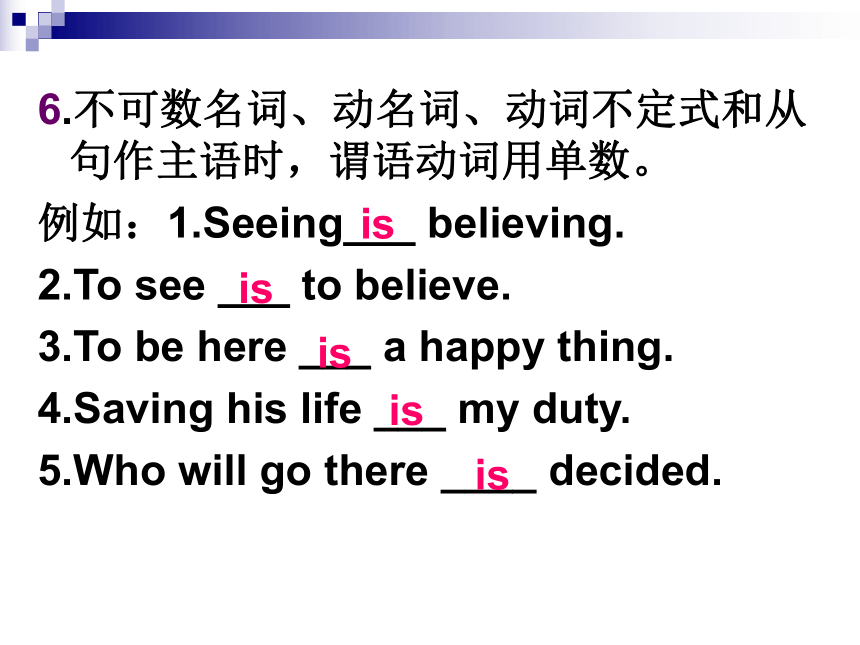
文档简介
(共41张PPT)
主谓一致
主谓一致:是指主语和谓语动词保持人称和数的一致。
主谓一致通常有三个原则:
语法一致原则;
意义一致原则;
就近一致原则。
I
am
seventeen.
We
are
seventeen.
He
is
a
teacher.
They
are
teachers.
Tom
often
gets
up
very
early
in
the
morning.
Nurses
have
a
meeting
every
morning
in
the
hospital.
一、语法一致原则:即形式上一致,谓语动词的单复数取决于其主语是单数还是复数。
1.不定代词
each;
another;
one…the
other;
neither;
either;
everyone;
everybody;
everything;
no
one;
someone;
somebody;
something;
anybody;
anyone;
anything;
nothing;
nobody作主语时,谓语动词用单数
例如:1.No
one____
(be)
absent.
2.____(be)
everyone
here?
3.There
are
two
books,
one
___
(be)
small,
the
other
___
(be)
big.
4.Either
of
the
answers
___(be)
right.
5.Each
of
us____
(have)
an
English
book
6.We
each
_____
(have)
an
English
book.
is
Is
is
is
is
has
have
2.each…and
each…;
many
a
…and
many
a
…;
no
…and
no…;
every
…and
every
…
;
many
a…;
each…;
every…作主语时,谓语动词用单数。
例如:1.Many
a
student
and
many
a
teacher
____(have)
seen
the
film.
2.
Many
students
____(be)
here.
3.Each
girl
and
each
boy
___
(be)
praised
at
the
meetings.
4.No
chair
and
no
desk
___(be)
permitted
to
be
taken
out.
5.Many
a
student____
busy
with
his
lessons.
has
are
is
is
was
3.
1)A/This/That
+
kind/type
of
+n.
(Cs/U)+谓(单)
2)One
of
+n.
(Cs)+谓(单)
3)A/This/That
pair
of
+
n.
(Cs)+谓(单)
4)名词+
of
+
this/that
+
kind/type
作主语时,谓语动词与名词保持一致。
例如:1.This
kind
of
apples____
highly
priced.
2.
Apples
of
this
kind____
highly
priced.
3.This
pair
of
trousers___
his.
4.A
pair
of
shoes___
under
the
bed.
My
shoes
___
under
the
bed.
5.One
of
them____
damaged.
is
are
is
is
are
is
4.more
than
one
+
名词单数;
the
number
of
+
n.
+谓(单)
a
number
of+
n.+谓(复)
例如:1.The
number
of
the
students
in
our
class____60.
2.A
number
of
the
students
___
(have)
seen
the
film.
3.More
than
one
person
____
injured
in
the
accident
yesterday.
is
is
have
5.表示时间、距离、金钱、度量等名词作主语,用于表示整体概念时,谓语动词用单数。
例如:1.Fifteen
minutes
___
not
enough.
2.Ten
miles____
too
much
for
him.
3.Twenty—five
dollars___
too
much
to
pay
for
the
coat.
4.Three
pounds
___
not
enough.
is
is
is
is
6.不可数名词、动名词、动词不定式和从句作主语时,谓语动词用单数。
例如:1.Seeing___
believing.
2.To
see
___
to
believe.
3.To
be
here
___
a
happy
thing.
4.Saving
his
life
___
my
duty.
5.Who
will
go
there
____
decided.
is
is
is
is
is
7.⑴表示两数相加、两数相乘作主语时,谓语动词既可用单数又可用复数。例如:
1.Fifteen
plus/and(加)five__________
(make)
twenty.
2.Five
times(乘)
six
________
thirty.
⑵表示两数相减、两数相除作主语时,谓语动词用单数。例如:
1.Fifteen
divided(除以)
by
three
___
five.
2.Five
minus(减)
two
____
three.
make/
makes
is/are
is
is
8.both,few,a
few,
many,
several等词及所修饰的名词作主语时,谓语动词用复数。
例如:1.Both
of
the
students
____
the
best.
2.Few
of
my
friends
_____
here.
3.A
few/Several
girls
____
going
to
see
a
film.
10.以“s”结尾的表示学科的名词
(
maths,physics,politics等)作主语时,谓语动词用单数。例如:
Politics
___
my
favorite
subject.
are
are
are
is
9.当主语是all,
most,
half,
part,
the
rest,
the
last,
the
remainder等词时,谓语动词取决于它所修饰的名词或所替代的名词的单复数。
例如:1.All
___
right.
2.All
___
present.
3.The
rest
of
the
book
___
interesting
4.The
rest
of
books
____
on
sale.
is
are
is
are
5.Most
of
the
wood
____
used
to
make
chairs.
6.Most
of
the
men
____
young
people.
7.Half
of
the
house
___
damaged.
8.Half
of
the
boys
____
going
to
the
library.
is
is
are
are
10.
⑴
a
lot
of,
lots
of,
plenty
of,
some
of,
all
of
①修饰不可数名词作主语时,谓语动词用单数。②修饰可数名词作主语时,谓语动词用复数。
⑵
①
none
of
+n.(C)+谓(单/复)
②
none
of
+n,(U)+谓(单)
(3)an
amount
of
/amounts
of+n.(U)+谓(单)
the
amount
of
+n.
(U)+谓(单)
(4)quantities
of
+n(U/C)+谓(复)
a
quantity
of
+
n.(C/U)+谓(单)
例如:1.There___
lots
of
people
waiting
outside.
2.
Lots
of
water
____
going
to
be
wasted.
3.Plenty
of
water
___
needed
by
everyone.
4.Plenty
of
books
___
needed
in
our
school.
5.None
of
my
friends
_____
here.
6.None
of
the
money
___
left.
are
is
are
is
is
is/are
7.Amounts
of
work
_____(have)
been
finished.
8.A
quantity
of
food
___
kept
in
the
cave.
9.A
quantity
of
books
___
sold
out.
10.Quantities
of
food
___
kept
in
the
cave.
11.Quantities
of
books
___
sold
out.
has
is
is
are
are
1.family,crew(全体人员),
audience,
group,
government,
team,
club,
public,
class,
enemy(敌人)
,
committee
(委员会)
等集体名词作主语,指整体概念时,谓语动词用单数。指成员时,谓语动词用复数。例如:1.Our
class
____
on
the
fourth
floor.
2.
Our
class
___
out.
is
are
二.意义一致原则
2.The
crew
___
made
up
of
able
men.
The
crew
___
busy
with
their
work.
3.My
family
___
not
large
My
family
___
watching
TV.
is
is
are
are
2.people,
youth(年轻人),cattle(牛),clothes
,police(警察)作主语时,谓语动词用复数。
例如:
1.The
police
___
searching
for
the
lost
child.
2.The
cattle
___
eating
grass.
are
are
3.⑴由and连接的两个名词,指同一事物,同一人,同一概念作主语时,谓语动词用单数。
例如:1.Bread
and
butter
___
their
daily
food.
2.The
writer
and
artist
___
known
to
us.
3.The
writer
and
the
artist____
known
to
us.
4.A
cart(运货车
)
and
horse
___
seen
in
the
distance.
5.A
knife
and
fork
___used
by
him.
6.Early
to
the
bed
and
early
to
rise
____a
good
habit.
is
is
are
is
is
is
相似的名词短语:
war
and
peace
战争与和平
truth
and
honesty
真诚
iron
and
steel
钢铁
a
watch
and
chain
一块带链的手表
a
needle
and
thread
一套针线
cause
and
effect
因果
bread
and
butter
黄油面包
the
writer
and
artist
作家兼艺术家
a
cart(运货车
)
and
horse
运货马车
a
knife
and
fork
一副刀叉
+谓(单)
⑵由and和both…and…连接的两个并列成分作主语时,谓语动词用复数。
例如:1.Both
bread
and
butter
___
popular
with
children.
2.The
black
and
the
white
cat
___
asleep.
3.The
black
and
white
cat
___asleep.
4.Water
and
air
___
necessary
to
people.
is
are
are
are
⑶由and连接的两个疑问词,接同一个动词不定式或同一个句子作主语时,谓语动词用单数。
例如:1.Where
to
find
him
and
how
to
find
him
____unknown
to
us.
2.How
and
why
he
had
to
come
to
New
York
____
a
story
of
success.
is
is
4.population
⑴作为”人口”讲时,为集合名词,单独作主语时,谓语动词用单数。
例如:The
population
of
China
is
large
than
that
of
Japan.
(2)如果population前有分数或百分数修饰作主语时,谓语动词用复数。
例如:Three
fourths
of
the
population
are
famers.
(3)形容人口多少用large/small
某地区的人口有多少,用has
a
population
of…
询问人口多少用What’s
the
population
of…
5.如果主语的中心名词后有with,
together
with,
as
well
as,
along
with,
but,
besides,
except,
in
addition
to,
not,
rather
than,
more
than,
including,
like(像),等,谓语动词取就远原则。
例如:1.The
teacher
with
two
students
___
at
the
meeting.
2.She
not
I
___
going
to
see
a
doctor.
3.The
girl
as
well
as
boys___(have)
seen
the
film.
4.You
rather
than
he____
punished
yesterday.
5.No
one
but
they____
my
friends.
is
is
has
were
is
6.(1)分数或百分数+n.(U)/n.(C单)
+谓(单)
(
2)分数或百分数+n.(Cs)
+谓(复)
(3)one
and
a
half
+
n.(C)
+谓(单)
(4)one
or
two
+n.(Cs)
+谓(复)
(5)a/an
+
名词单数
+
or
two
+谓(单)
例如:1.Three
fourths
of
the
surface
on
the
earth
___
sea.
2.Two
thirds
of
the
people
___
against
the
plan.
3.One
and
a
half
apples
___
a
good
meal
for
the
beggar(乞丐
).
4.One
or
two
days
___enough
for
the
work.
5.A
day
or
two
___
enough
for
the
work.
is
is
is
are
are
7.sheep,means,deer,Chinese,Japanese等单复数同形的名词作主语时,谓语动词根据其意义决定。
例如:1.One
sheep
____
enough.
2.Ten
sheep
____
missing.
3.Every
means
___
tried.
4.All
means
___
tried.
is
is
are
are
8.the
+
adj./done/doing
表一类人+谓(复)
表事物,谓(单)
例如:1.The
old
___
taken
good
care
of
by
the
government.
2.The
injured
___
taken
to
hospital
immediately.
3.The
beautiful
_____(give)
pleasures
to
all
of
us.
are
are
gives
9.(1)在定语从句中,
one
of
+
名词复数
+
that/who
+
谓语动词的复数形式
the
only/very/just/last
one
of
+
名词复数
+
who/that
+
谓语动词的单数形式。
例如:1.He
is
one
of
the
students
who
___
praised.
2.He
is
the
only
one
of
the
students
who
___
praised.
are
is
(2)在定语从句中,关系代词作主语时,其谓语动词的单复数与先行词保持一致。
Anyone
who
doesn’t
come
must
be
punished.
10.疑问词:which,
what,
who作主语时,根据意义决定谓语动词的单复数。
例如:1.Which
___
your
room.
2.Which
___
your
rooms.
3.What
I
say
and
think____
out
of
your
business.
4.Who
___
your
brother.
5.Who
___
your
classmates.
is
are
are
is
are
11.在强调句中,强调主语时,谓语动词与被强调的部分保持一致。
例如:1.It
was
he
that
____
invited
to
the
party.
2.It
is
I
that
____
your
friend.
was
am
12.such作主语时,谓语动词的单复数根据其意义而定。
例如:1.Such
____
what
he
said.
2.She
wants
to
have
a
big
bed
and
many
toys,
such
____
her
wishes.
was
are
三、就近原则
1.Here/There
+
be/exist/live/stand/lie
连接几个主语时,谓语动词取就近原则。
例如:1.There
___
a
pen
and
two
books.
2.There
___
two
books
and
a
pen.
3.Here
___
a
pen
and
a
few
books.
4.
Here
___
a
few
books
and
a
pen.
5.There
______(stand)
a
large
buildings.
6.In
our
hometown,
there____
(live)
2000
people
is
is
are
are
stands
live
2.由or,
either…or,
neither…nor,
not
only…but
also…,
not…but…连接两个主语时,谓语动词取就近原则。
例如:1.Not
only
he
but
also
his
parents
___
at
home.
2.Either
you
or
I
___
wrong.
3.____
either
you
or
I
wrong?
4.Not
you
but
I
___
to
answer
for
it.
5.___
neither
he
nor
I
for
the
agreement.
are
am
Are
am
Is
主谓一致
主谓一致:是指主语和谓语动词保持人称和数的一致。
主谓一致通常有三个原则:
语法一致原则;
意义一致原则;
就近一致原则。
I
am
seventeen.
We
are
seventeen.
He
is
a
teacher.
They
are
teachers.
Tom
often
gets
up
very
early
in
the
morning.
Nurses
have
a
meeting
every
morning
in
the
hospital.
一、语法一致原则:即形式上一致,谓语动词的单复数取决于其主语是单数还是复数。
1.不定代词
each;
another;
one…the
other;
neither;
either;
everyone;
everybody;
everything;
no
one;
someone;
somebody;
something;
anybody;
anyone;
anything;
nothing;
nobody作主语时,谓语动词用单数
例如:1.No
one____
(be)
absent.
2.____(be)
everyone
here?
3.There
are
two
books,
one
___
(be)
small,
the
other
___
(be)
big.
4.Either
of
the
answers
___(be)
right.
5.Each
of
us____
(have)
an
English
book
6.We
each
_____
(have)
an
English
book.
is
Is
is
is
is
has
have
2.each…and
each…;
many
a
…and
many
a
…;
no
…and
no…;
every
…and
every
…
;
many
a…;
each…;
every…作主语时,谓语动词用单数。
例如:1.Many
a
student
and
many
a
teacher
____(have)
seen
the
film.
2.
Many
students
____(be)
here.
3.Each
girl
and
each
boy
___
(be)
praised
at
the
meetings.
4.No
chair
and
no
desk
___(be)
permitted
to
be
taken
out.
5.Many
a
student____
busy
with
his
lessons.
has
are
is
is
was
3.
1)A/This/That
+
kind/type
of
+n.
(Cs/U)+谓(单)
2)One
of
+n.
(Cs)+谓(单)
3)A/This/That
pair
of
+
n.
(Cs)+谓(单)
4)名词+
of
+
this/that
+
kind/type
作主语时,谓语动词与名词保持一致。
例如:1.This
kind
of
apples____
highly
priced.
2.
Apples
of
this
kind____
highly
priced.
3.This
pair
of
trousers___
his.
4.A
pair
of
shoes___
under
the
bed.
My
shoes
___
under
the
bed.
5.One
of
them____
damaged.
is
are
is
is
are
is
4.more
than
one
+
名词单数;
the
number
of
+
n.
+谓(单)
a
number
of+
n.+谓(复)
例如:1.The
number
of
the
students
in
our
class____60.
2.A
number
of
the
students
___
(have)
seen
the
film.
3.More
than
one
person
____
injured
in
the
accident
yesterday.
is
is
have
5.表示时间、距离、金钱、度量等名词作主语,用于表示整体概念时,谓语动词用单数。
例如:1.Fifteen
minutes
___
not
enough.
2.Ten
miles____
too
much
for
him.
3.Twenty—five
dollars___
too
much
to
pay
for
the
coat.
4.Three
pounds
___
not
enough.
is
is
is
is
6.不可数名词、动名词、动词不定式和从句作主语时,谓语动词用单数。
例如:1.Seeing___
believing.
2.To
see
___
to
believe.
3.To
be
here
___
a
happy
thing.
4.Saving
his
life
___
my
duty.
5.Who
will
go
there
____
decided.
is
is
is
is
is
7.⑴表示两数相加、两数相乘作主语时,谓语动词既可用单数又可用复数。例如:
1.Fifteen
plus/and(加)five__________
(make)
twenty.
2.Five
times(乘)
six
________
thirty.
⑵表示两数相减、两数相除作主语时,谓语动词用单数。例如:
1.Fifteen
divided(除以)
by
three
___
five.
2.Five
minus(减)
two
____
three.
make/
makes
is/are
is
is
8.both,few,a
few,
many,
several等词及所修饰的名词作主语时,谓语动词用复数。
例如:1.Both
of
the
students
____
the
best.
2.Few
of
my
friends
_____
here.
3.A
few/Several
girls
____
going
to
see
a
film.
10.以“s”结尾的表示学科的名词
(
maths,physics,politics等)作主语时,谓语动词用单数。例如:
Politics
___
my
favorite
subject.
are
are
are
is
9.当主语是all,
most,
half,
part,
the
rest,
the
last,
the
remainder等词时,谓语动词取决于它所修饰的名词或所替代的名词的单复数。
例如:1.All
___
right.
2.All
___
present.
3.The
rest
of
the
book
___
interesting
4.The
rest
of
books
____
on
sale.
is
are
is
are
5.Most
of
the
wood
____
used
to
make
chairs.
6.Most
of
the
men
____
young
people.
7.Half
of
the
house
___
damaged.
8.Half
of
the
boys
____
going
to
the
library.
is
is
are
are
10.
⑴
a
lot
of,
lots
of,
plenty
of,
some
of,
all
of
①修饰不可数名词作主语时,谓语动词用单数。②修饰可数名词作主语时,谓语动词用复数。
⑵
①
none
of
+n.(C)+谓(单/复)
②
none
of
+n,(U)+谓(单)
(3)an
amount
of
/amounts
of+n.(U)+谓(单)
the
amount
of
+n.
(U)+谓(单)
(4)quantities
of
+n(U/C)+谓(复)
a
quantity
of
+
n.(C/U)+谓(单)
例如:1.There___
lots
of
people
waiting
outside.
2.
Lots
of
water
____
going
to
be
wasted.
3.Plenty
of
water
___
needed
by
everyone.
4.Plenty
of
books
___
needed
in
our
school.
5.None
of
my
friends
_____
here.
6.None
of
the
money
___
left.
are
is
are
is
is
is/are
7.Amounts
of
work
_____(have)
been
finished.
8.A
quantity
of
food
___
kept
in
the
cave.
9.A
quantity
of
books
___
sold
out.
10.Quantities
of
food
___
kept
in
the
cave.
11.Quantities
of
books
___
sold
out.
has
is
is
are
are
1.family,crew(全体人员),
audience,
group,
government,
team,
club,
public,
class,
enemy(敌人)
,
committee
(委员会)
等集体名词作主语,指整体概念时,谓语动词用单数。指成员时,谓语动词用复数。例如:1.Our
class
____
on
the
fourth
floor.
2.
Our
class
___
out.
is
are
二.意义一致原则
2.The
crew
___
made
up
of
able
men.
The
crew
___
busy
with
their
work.
3.My
family
___
not
large
My
family
___
watching
TV.
is
is
are
are
2.people,
youth(年轻人),cattle(牛),clothes
,police(警察)作主语时,谓语动词用复数。
例如:
1.The
police
___
searching
for
the
lost
child.
2.The
cattle
___
eating
grass.
are
are
3.⑴由and连接的两个名词,指同一事物,同一人,同一概念作主语时,谓语动词用单数。
例如:1.Bread
and
butter
___
their
daily
food.
2.The
writer
and
artist
___
known
to
us.
3.The
writer
and
the
artist____
known
to
us.
4.A
cart(运货车
)
and
horse
___
seen
in
the
distance.
5.A
knife
and
fork
___used
by
him.
6.Early
to
the
bed
and
early
to
rise
____a
good
habit.
is
is
are
is
is
is
相似的名词短语:
war
and
peace
战争与和平
truth
and
honesty
真诚
iron
and
steel
钢铁
a
watch
and
chain
一块带链的手表
a
needle
and
thread
一套针线
cause
and
effect
因果
bread
and
butter
黄油面包
the
writer
and
artist
作家兼艺术家
a
cart(运货车
)
and
horse
运货马车
a
knife
and
fork
一副刀叉
+谓(单)
⑵由and和both…and…连接的两个并列成分作主语时,谓语动词用复数。
例如:1.Both
bread
and
butter
___
popular
with
children.
2.The
black
and
the
white
cat
___
asleep.
3.The
black
and
white
cat
___asleep.
4.Water
and
air
___
necessary
to
people.
is
are
are
are
⑶由and连接的两个疑问词,接同一个动词不定式或同一个句子作主语时,谓语动词用单数。
例如:1.Where
to
find
him
and
how
to
find
him
____unknown
to
us.
2.How
and
why
he
had
to
come
to
New
York
____
a
story
of
success.
is
is
4.population
⑴作为”人口”讲时,为集合名词,单独作主语时,谓语动词用单数。
例如:The
population
of
China
is
large
than
that
of
Japan.
(2)如果population前有分数或百分数修饰作主语时,谓语动词用复数。
例如:Three
fourths
of
the
population
are
famers.
(3)形容人口多少用large/small
某地区的人口有多少,用has
a
population
of…
询问人口多少用What’s
the
population
of…
5.如果主语的中心名词后有with,
together
with,
as
well
as,
along
with,
but,
besides,
except,
in
addition
to,
not,
rather
than,
more
than,
including,
like(像),等,谓语动词取就远原则。
例如:1.The
teacher
with
two
students
___
at
the
meeting.
2.She
not
I
___
going
to
see
a
doctor.
3.The
girl
as
well
as
boys___(have)
seen
the
film.
4.You
rather
than
he____
punished
yesterday.
5.No
one
but
they____
my
friends.
is
is
has
were
is
6.(1)分数或百分数+n.(U)/n.(C单)
+谓(单)
(
2)分数或百分数+n.(Cs)
+谓(复)
(3)one
and
a
half
+
n.(C)
+谓(单)
(4)one
or
two
+n.(Cs)
+谓(复)
(5)a/an
+
名词单数
+
or
two
+谓(单)
例如:1.Three
fourths
of
the
surface
on
the
earth
___
sea.
2.Two
thirds
of
the
people
___
against
the
plan.
3.One
and
a
half
apples
___
a
good
meal
for
the
beggar(乞丐
).
4.One
or
two
days
___enough
for
the
work.
5.A
day
or
two
___
enough
for
the
work.
is
is
is
are
are
7.sheep,means,deer,Chinese,Japanese等单复数同形的名词作主语时,谓语动词根据其意义决定。
例如:1.One
sheep
____
enough.
2.Ten
sheep
____
missing.
3.Every
means
___
tried.
4.All
means
___
tried.
is
is
are
are
8.the
+
adj./done/doing
表一类人+谓(复)
表事物,谓(单)
例如:1.The
old
___
taken
good
care
of
by
the
government.
2.The
injured
___
taken
to
hospital
immediately.
3.The
beautiful
_____(give)
pleasures
to
all
of
us.
are
are
gives
9.(1)在定语从句中,
one
of
+
名词复数
+
that/who
+
谓语动词的复数形式
the
only/very/just/last
one
of
+
名词复数
+
who/that
+
谓语动词的单数形式。
例如:1.He
is
one
of
the
students
who
___
praised.
2.He
is
the
only
one
of
the
students
who
___
praised.
are
is
(2)在定语从句中,关系代词作主语时,其谓语动词的单复数与先行词保持一致。
Anyone
who
doesn’t
come
must
be
punished.
10.疑问词:which,
what,
who作主语时,根据意义决定谓语动词的单复数。
例如:1.Which
___
your
room.
2.Which
___
your
rooms.
3.What
I
say
and
think____
out
of
your
business.
4.Who
___
your
brother.
5.Who
___
your
classmates.
is
are
are
is
are
11.在强调句中,强调主语时,谓语动词与被强调的部分保持一致。
例如:1.It
was
he
that
____
invited
to
the
party.
2.It
is
I
that
____
your
friend.
was
am
12.such作主语时,谓语动词的单复数根据其意义而定。
例如:1.Such
____
what
he
said.
2.She
wants
to
have
a
big
bed
and
many
toys,
such
____
her
wishes.
was
are
三、就近原则
1.Here/There
+
be/exist/live/stand/lie
连接几个主语时,谓语动词取就近原则。
例如:1.There
___
a
pen
and
two
books.
2.There
___
two
books
and
a
pen.
3.Here
___
a
pen
and
a
few
books.
4.
Here
___
a
few
books
and
a
pen.
5.There
______(stand)
a
large
buildings.
6.In
our
hometown,
there____
(live)
2000
people
is
is
are
are
stands
live
2.由or,
either…or,
neither…nor,
not
only…but
also…,
not…but…连接两个主语时,谓语动词取就近原则。
例如:1.Not
only
he
but
also
his
parents
___
at
home.
2.Either
you
or
I
___
wrong.
3.____
either
you
or
I
wrong?
4.Not
you
but
I
___
to
answer
for
it.
5.___
neither
he
nor
I
for
the
agreement.
are
am
Are
am
Is
同课章节目录
